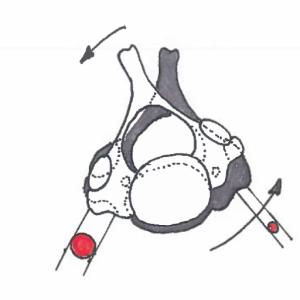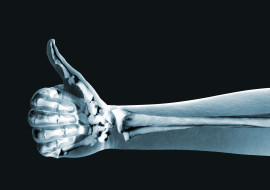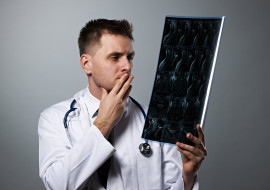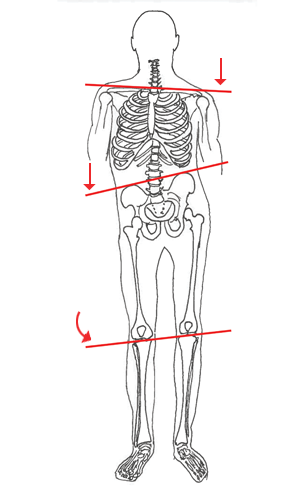- 1. The structure governs the function.
When we talk about the structure, we mean the bones, their tendons, ligaments, organs and their supporting tissue. Blood vessels and nerve fibers pass by all these elements, allowing the body to move and to respond to vital functions.
Each disturbance (traumatic, stress, bad posture, surgery, …) of a structure which is in relationship with the nerve vessels will be transferred to the central nervous system. This information is then analysed and a recovery mechanism is triggered, in synergy with the immune system and the hormonal system (regulating systems).
In the model which we represent, it is obvious that a mechanical blockage either near the exit of the spinal nerves or in their course, could evoque an inflammation that can manifest in a part of the skin (dermatome), an organ (viscerotome), connective tissue (sclerotome) os in a muscle (myotome), depending on the severity of the (over) stimulation.
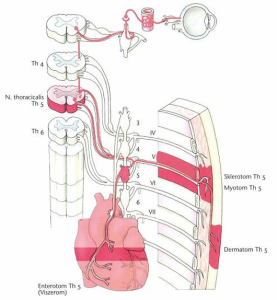
A bad, crooked, rigid body structure can after some time lead to blockages in joints, decreased blood circulation, decreased mobility of organs such as lungs, intestines, stomach, …. and therefore create a reduced function.

- 2. A non-infectious disease of the skin or another organ (e.g. asthma, allergy, eczema, psoriasis, …) can only exist if there is a direct link between this place and the nervous system.
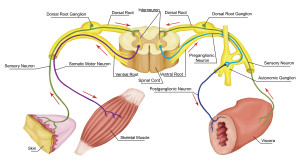
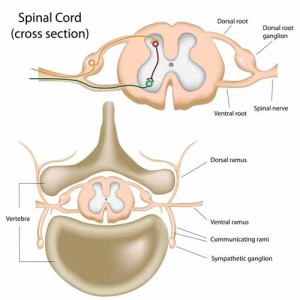
The most important role in this matter is played by the central axis of the body: the spine ! This bony and mobile structure guarantees protection to a part of the central nervous system (CNS): the spinal cord.
From each segment of the spinal cord, between two vertebra, one pair of nerves leaves the spinal column through a small hole, the intervertebral foramen. Each pair of nerves then continues its way to organs, muscles, articulations, connective tissue, blood vessels, … of the concerned level.

The space in the spinal column foreseen for the nerves (intervertebral channel), and the space where the nerves leave the spinal column are quite limited.
When this space is reduced even more, it could possibly irritate a nerve, acutely or chronically.
This irritation can occur in cases of arthrosis, disc problems, but also in permanent oblique situations of the spine, small dislocations and blockages of the vertebrae.
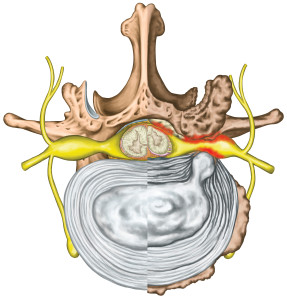
On this illustration you can see how a lateral tilting of a vertebra will narrow the space where a nerve leaves the spine.
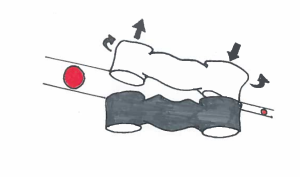
The same phenomenon occurs during a rotational movement of a vertebra: the channel in which the nerve passes will be narrowed at the side of the rotation.
The reduction and the increase of the places of passage are physiologically spoken perfectly normal, as long as there is no loss of mobility between the vertebrae.
As soon as the structure of the vertebral column changes and certain vertebrae lose their mobility, a chronic irritation or inflammation can occur.
In most cases, this occurence is hardly even felt by the patient.
As soon as a nerve gets irritated, nociceptive stimuli are sent up to the brain (CNS) through the spinal cord.
Our clinical experiences actually confirm the observations of J. Gesret : « Asthme et vérité fondamentale »
People who suffer from asthma, allergy, eczema, psoriasis, … all show divergent behavior of the skeleton.
There is a diffeerence between a healthy and a “sick” person.
Complaints such as asthma, hay fever, eczema, … will disappear spontaneously after restructuration of the spine and disappearance of the blockades of the vertebrae and other joints.
Often, the construction of a wrong body structure starts from a discrepancy in leg length.

